Related Research Articles

Fish anatomy is the study of the form or morphology of fish. It can be contrasted with fish physiology, which is the study of how the component parts of fish function together in the living fish. In practice, fish anatomy and fish physiology complement each other, the former dealing with the structure of a fish, its organs or component parts and how they are put together, such as might be observed on the dissecting table or under the microscope, and the latter dealing with how those components function together in living fish.

The Zeidae are a family of large, showy, deep-bodied zeiform marine fish—the "true dories". Found in the Atlantic, Indian, and Pacific Oceans, the family contains just six species in two genera. All species are important and highly regarded food fish supporting commercial fisheries, and some—such as the John Dory —are enjoyed in large public aquaria. These fish are caught primarily by deep-sea trawling.

The greenback flounder is a righteye flounder of the genus Rhombosolea, found around southern Australia and New Zealand.
Breitensteinia is a genus of catfishes of the family Akysidae. It includes three species.

Acrochordonichthys is a genus of catfishes of the family Akysidae. It includes ten species.
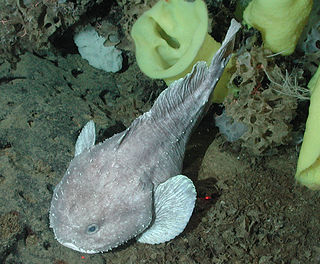
The blob fish is a species of deep-sea fish of the family Psychrolutidae. It feeds mainly on crustaceans, molluscs, and sea pens.

Tristichopterus, with a maximum length of sixty centimetres, is the smallest genus in the family of prehistoric lobe-finned fish, Tristichopteridae that was believed to have originated in the north and dispersed throughout the course of the Upper Devonian into Gondwana. Tristichopterus currently has only one named species, first described by Egerton in 1861. The Tristichopterus node is thought to have originated during the Givetian part of the Devonian. Tristichopterus was thought by Egerton to be unique for its time period as a fish with ossified vertebral centers, breaking the persistent notochord rule of most Devonian fish but this was later reinspected and shown to be only partial ossification by Dr. R. H. Traquair. Tristichopterus alatus closely resembles Eusthenopteron and this sparked some debate after its discovery as to whether it was a separate taxon.
Gobioclinus gobio is a strictly marine ray finned fish, also called Gobioclinus gobio. Its common name is the palehead blenny, and is sometimes referred to as the goggle-eye blenny. It can be identified by its greenish top, red belly, and multicolored banding. L. gobio is a benthic organism with a wide range, taking up residence in a number of coastal environments from Florida to Brazil. This means the fish can live in equatorial, subtropical, and tropical climatic zones. It is native to coastal areas of the Caribbean. Its diet consists mainly of different molluscs and echinoderms.
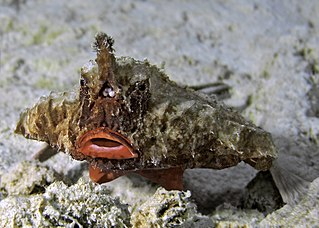
Ogcocephalus corniger, the longnose batfish, is a species of ray-finned fish belonging to the family Ogcocephalidae, the deep sea batfishes. This fish is found at depths between 29 and 230 m in the Atlantic Ocean, ranging from North Carolina to the Gulf of Mexico and the Bahamas. Like other members of the family Ogcocephalidae, it has a flat triangular body with coloring varying from yellowish to purple with pale, round spots. The lips are orange-red. Projecting from its head is a characteristic structure that is shared by other anglerfish.
Nemipterus isacanthus, the teardrop threadfin bream or twinlined threadfin bream, is a species of marine ray-finned fish belonging to the family Nemipteridae, the threadfin and whiptail breams. This fish is found in the western Pacific Ocean.
Astyanax microschemos is a species of characid fish from Brazil. It belongs to the A. scabripinnis species complex and differs from other species outside it by having a lower number of branched anal fin rays and its shallow body depth being about 26.9-29.7 vs more than 35% of its standard length (SL). Compared to species of its own complex, it can be distinguished by the combination of its shallow body depth, and smaller interorbital width. The species name comes from the Greek mikroschemos, meaning "low stature", which refers to the shallow body depth of the animal.

Deuterodon pelecus is a species of characid fish from Brazil. It can be distinguished from other species by: its body depth ; its short and pointed snout smaller than the orbital diameter; and a reduced number of branched anal fin rays. D. pelecus also differs from members of its genus by its characteristic color pattern. It possesses a single humeral spot that is constricted to the region above the lateral line; at the same time it shows a conspicuous midlateral body stripe from opercle to the caudal fin base, an autapomorphy of this precise species. Other Deuterodon species have a humeral spot that is vertically or horizontally elongate and have the midlateral stripe becoming faint near that humeral spot. The species name is derived from the Greek pelekus, meaning "axe", referring to the pigmentation shape resulting from the adjoinment of the humeral spot with the midlateral stripe.
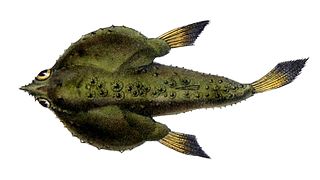
Ogcocephalus notatus, the marked batfish, is a species of ray-finned fish belonging to the family Ogcocephalidae, the deep sea batfishes. It is found in the tropical western Atlantic Ocean.
Ogcocephalus porrectus, the rosy-lipped batfish, is endemic to Cocos Island off the Pacific coast of Costa Rica. Though members of Ogcocephalidae occur in tropical, warm waters in both the Western Atlantic and Eastern Pacific. Rosy-lipped batfish generally reside in shallow to deep water benthic zones with a bathymetric range of 35 – 150 m. The syntypic series was collected at 120 m on a rocky bottom. What makes this fish distinctive are its rosy red lips, specialized pectoral fins used for "walking", and an illicium used for attracting prey.
Archolaemus luciae is a species of glass knifefish endemic to Brazil where it is found in the Rio Jari, the Rio Trombetas and the Rio Tapajós basins in the eastern Amazon. Also found in the Rio Araguari. This species reaches a length of 49.7 cm (19.6 in).
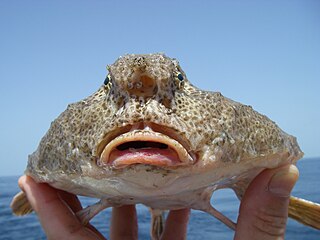
Ogcocephalus declivirostris, the slantbrow batfish, is a species of ray-finned fish belonging to the family Ogcocephalidae, the deep sea batfishes. This species is found in the western Atlantic Ocean from the northern Gulf of Mexico to the Straits of Florida.
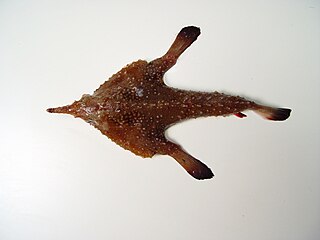
Ogcocephalus pumilus, the dwarf batfish, is a species of ray-finned fish belonging to the family Ogcocephalidae, the deep sea batfishes. It is found in the western Atlantic Ocean. It is the smallest species in the genus Ogcocephalus.
Ogcocephalus rostellum, the palefin batfish, is a species of ray-finned fish belonging to the family Ogcocephalidae, the deep sea batfishes. It is found in the western Atlantic Ocean.

Ogcocephalus cubifrons, the spotted batfish or polka-dot batfish, is a species of ray-finned fish belonging to the family Ogcocephalidae, the deep sea batfishes. This is an uncommon demersal fish found in the Western Atlantic Ocean and the southern Gulf of Mexico, in the United States, Mexico and the Bahamas.

Ogcocephalus nasutus, the shortnose batfish, is a species of ray-finned fish belonging to the family Ogcocephalidae, the deep sea batfishes. This species is found in the western Atlantic Ocean and the Caribbean.
References
- ↑ Ruschenberger, William Samuel Waithman (1846). Elements of Herpetology, and of Ichthyology: Prepared for the Use of Schools and Colleges. Grigg & Elliot. pp. 129–145.
Further reading
- Moyle, Peter; Cech, Joseph (2004). Fishes: An Introduction to Ichthyology. Pearson Prentice Hall. ISBN 9780131008472.